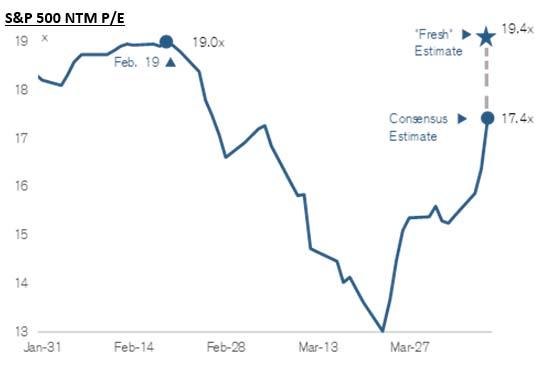
Following today's market surge, this disconnect got even greater because as earnings estimates fell further...
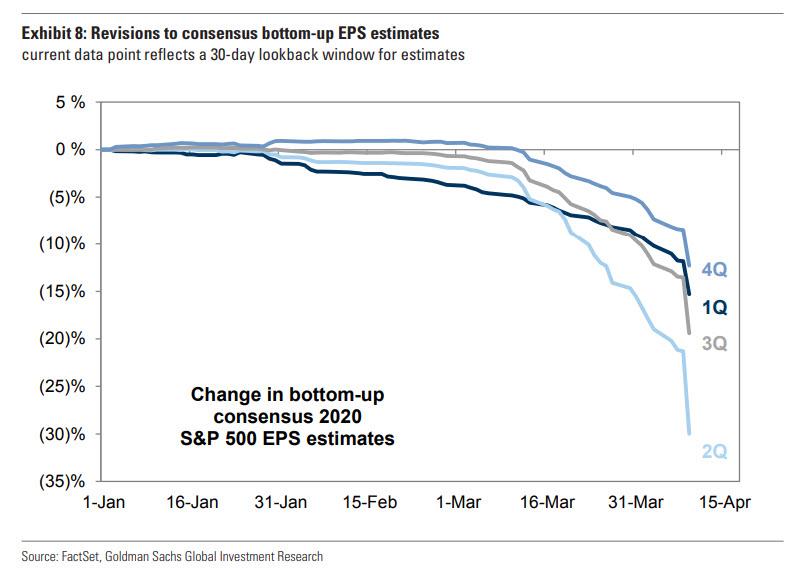
... stocks rose, and the latest PE multiple (on 2021 earnings mind you) is now a dot com bubble-eseque 24x.
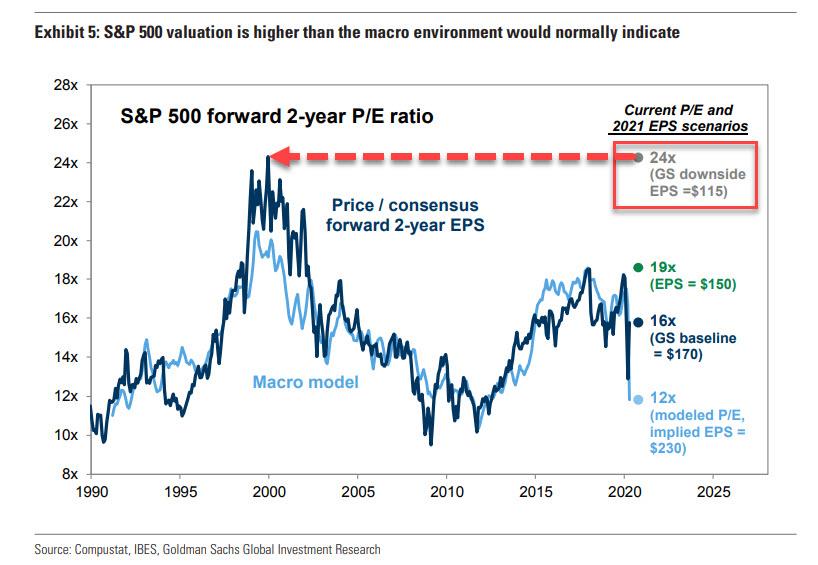
That this it taking place as the global economy careens into the biggest contraction in generations is patently absurd, or would be if the Fed had not directly taken over markets to lift risk prices in a move that has gotten even the world's largest asset manager openly admitting the only strategy left is to buy what the Fed is buying.
Meanwhile, with asset prices now completely disconnected from underlying earnings, the global economy can go to hell in a hand basket and none of the billionaires in control will mind - after all the value of their stock holdings is once again fast approaching all time high.
And speaking of hell in a hand basket, that's precisely where the global economy is headed despite what the market may be signaling, because while global GDP is now expected to slump 14% in the first half of 2020 according to JPM, resulting in the US losing a "stunning and unprecedented 25 million workers and pushing the unemployment rate to a level last seen in the Great Depression", a more important question is what happens to corporate profits, and it is here that the real pain - at least for those tasked to find a connection between profits and stock prices - comes because according to JPM, since global profits are levered to GDP and not to the Fed's balance sheet, the largest US commercial bank (which itself reported the biggest plunge in its profits since the financial crisis) expects global profits to plunge by 70% in Q2 2020.
How does JPM get this number? As the bank's economist Joseph Lipton explains, in the 2001 recession, global GDP growth slowed by 3.7%-pts. Over this same period, global corporate profit growth slumped roughly 62%-pts—a huge decline driven in part by the crash of the tech bubble. Next, in the global financial crisis, global GDP growth slumped 9.8%, while corporate profit growth tumbled nearly 68.5%-pts—a profit to GDP "beta" of seven.
In the current recession, JPM expects global GDP growth to collapse by the same 9.8%-points in the year through Q2 202 relative to the prior year. Despite the differing nature of the shocks and additional significant hit to the service sector now,
JPM still assumes a beta of seven—on par with the global financial crisis. This implies a plunge in corporate profits of roughly 70% in the year through 2Q20.
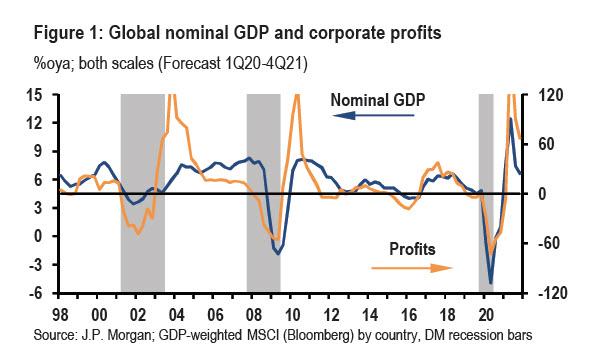
While earnings will get support from fiscal and monetary policy, that support will come at a cost to tax payers according to JPM. Government debt will surge well over 10%-pts of GDP this year and rise further in 2021. Most policy actions are aimed at supporting aggregate demand, thereby indirectly cushioning private sector income loses. Still, some actions will directly boost profits through tax and credit policies. Nevertheless, despite the huge policy supports, JPM concludes that "the global profit loss will likely still be material" and from the bank's top-down macro perspective, "global corporate profits look set to crater 72% in the year through 2Q20."
It gets worse: while many expect a V- or even U shaped recovery, JPM admits that even with the projected strong subsequent rebound, global profits are expected to stand more than 20% below their forecasted pre-pandemic level at the end of 2021!
In other words, profits won't recover their pre-pandemic baseline until some time in 2022 if not 2023, which is terrible news for Wall Street strategists as it means they will now have to apply forward multiples from 2023 for their optimistic recos to make any sense.
Overall, lost profits will cumulate to roughly three-fourths of one-year's earnings by the end of 2021 (50% in 2020 and another 25% in 2021). The reason for JPM's dour take: "with corporate debt set to balloon and a significant rise in bankruptcies increasingly likely, the overall deterioration of corporate sector balance sheets will likely be an ongoing legacy of the COVID-19 shock."
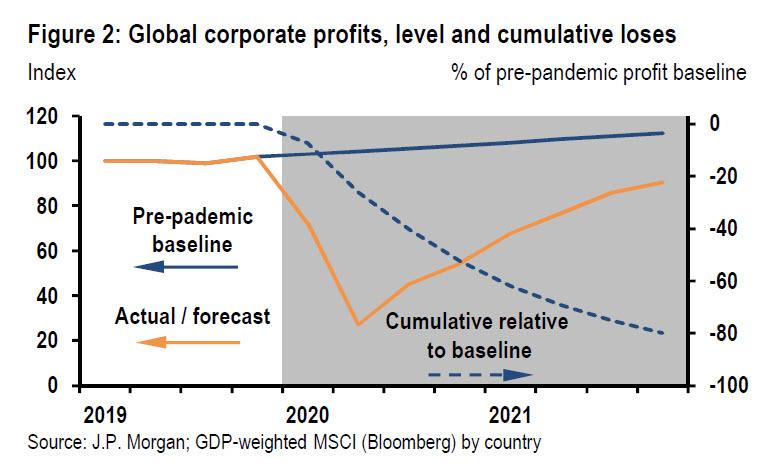
JPM then admits that even this catastrophic forecast could prove to be optimistic as the projected path of profits is based on the historical response to nominal GDP growth; and while the relationship is fairly robust (Figure 1), such an exercise is rife with uncertainty given the unique nature of the COVID-19 shock as well as the policy response. As a result, the breadth of the shock to sectors that are usually less impacted by the cycle (namely services) suggests profit losses could be amplified. As such, "it remains likely that the path ahead will incorporate both a significant hit to profits and large rise in corporate debt outstanding."
JPM saves the worst possible scenario for last: according to the bank's economists, the breadth of this recession could also amplify the breadth of the hit to profits. Unlike the GFC, which began as a financial market shock in the US, the COVID-19 pandemic has spread globally. Consequently, each country is experiencing both a loss of external demand (typical for a global recession) and a unique hit to domestic demand from containment policies.
The same argument can be applied to the outlook across sectors. Although profits dropped 50-60% in each of the past two global recessions, the composition varied (aside from earnings in the energy sector, which dropped 42% peak to trough in both). The 2001 recession owed to the bursting of the tech bubble. Both IT and Telecom experienced massive declines in earnings: 64% and 40%, respectively. Tech was hit in the GFC but only about one-half as much as in 2001, while Telecom fared well. Rather, the GFC hit the financial sector hard. In contrast to the 2001 recession, when financial earnings were only down 19%, the GFC exacted a 72% toll on the sector. Materials were hit even more, down 80% compared to 29% in the 2001 recession. This discrepancy owes to the fact that the 2001 recession sparked the beginning of the housing bubble, which ended badly in the GFC.
Long story short, investment banks which have given up on 2020 as a forward PE anchor - because nobody knows what happens this year yet somehow everyone knows what will happen next year - and are instead using 2021 now, will soon have to go forward even more and within the next several months, we expect to see PE valuations models based on 2022 earnings and eventually 2023. At some point the market will realize that such a "valuation" - which is merely an excuse for not admitting the terminal disconnect between fundamentals and prices - is idiotic and absurd, and when that happens, the S&P will not only take out the March 24 lows but sprint right for the March 2009 "generational bottom."
And a quick tangent: there is a possibility, if companies rush to make Q2 a kitchen sink quarter, that Q2 earnings will not even be positive. Which, in keeping with the idiocy of these centrally planned markets where the lower the EPS, the exponentially higher the PE, would mean that there is a distinct probability that - with the Fed's blessing of course - the S&P500 could hit +∞ in the coming weeks.
Commenti
Posta un commento